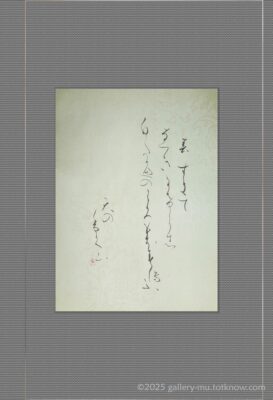#232 Spring has passed, …

| Size: | about 33×24 cm |
|---|---|
| Dressing: | framed |
What kind of verse?
| verse: | Haru sugi te, natsu ki ni kerashi, shirotae no, koromo hosu chou, ama no kaguyama |
|---|---|
| (imho): | Spring has passed, it seems, and summer has come. White robes flutter in the breeze on sacred Mount Amanokagu, just as they say they do in early summer. |
| poet: | Empress Jitō |
| in: | before 703 |
What did Empress Jitō want to express?
This poem is the most famous of the Ogura Hyakunin Isshu, and it was originally poem number 28 in the Manyoshu, Volume 1.
In fact, this song is unique and shrouded in mystery, and various studies have been conducted on it since ancient times.
The mystery of the waka poem “Spring has passed…”
- Is Mount Kagu’s white robes just a metaphor or a real sight?
- Why does that mean summer is coming?
- The usage of “rashi” and “kan” differs from other poems in the Manyoshu.
- There is no other example in the Man’yoshu collection of poems that records the year of accession to the throne as “Gannen Dinghai.”
・・・
What are Empress Jito’s true intentions revealed through the results of this research?!
- This song is not simply a seasonal song, but a poem that symbolically expresses the legitimacy of the imperial line .
- In particular, the expression “shirotae no robes” drying on Mount Kagu is imbued with religious and ritualistic meaning, which seems to allude to “the arrival of summer = a new reign.”
- Therefore, the phrase “Spring has passed and summer has come” can be interpreted as a highly political and symbolic expression indicating the succession and justification of the imperial line from Jitō to Mommu .
Regardless of the meaning behind the song
Empress Jitō was the daughter of Emperor Tenchi and the Empress of Emperor Tenmu. It is said that she expelled Prince Otsu in order to have her own son, Prince Kusakabe, succeed the throne, but she is also said to have given instructions regarding the contents of the Kojiki to support the legitimacy of her grandson, Emperor Mommu.
From these anecdotes, she is sometimes seen as an ambitious and scheming person, but at the same time, she also had a progressive side, as she was the first emperor to be cremated, and we can see that she was a pioneering figure for the times. She was a multifaceted and extremely fascinating woman.
It is also wonderful to think that she was so captivated by a scene she happened to see during her visit to Yoshino – white robes drying against the backdrop of the blue summer sky and the deep green of Mount Kagu – that she turned it into a song.
This piece follows the exact meaning of the poem and is written in fluttering lines, imagining a scene of clothing fluttering in the wind.

